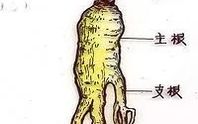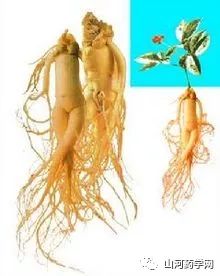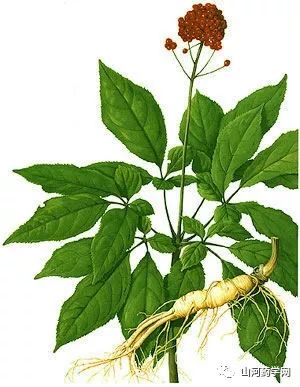| GinsengRén Shēn | |
|---|---|
|
|
|
| Alias | Bàng chuí, Shān shēn, Yuán shēn, Rén xián, Guǐ gài, Tǔ jīng, Shén cǎo, Huáng shēn, Xuè shēn, Dì jīng, Bǎi chǐ chǔ, Hǎi yú, Jīn jǐng yù lán, Hái ér shēn, Bàng cuì, Rén jiē, Yù jīng |
| Effects | 补气 (Tonifies Qi), 固脱 (Stabilizes Collapse), 生津 (Generates Fluids), 安神 (Calms the Spirit), 益智 (Benefits the Mind). Used for shortness of breath, palpitations, forgetfulness, excessive thirst, profuse sweating, lack of appetite, weakness, and all acute and chronic diseases, as well as shock and collapse due to blood loss. |
| English Name | Ginseng, Ginseng Root |
| First Recorded In | Shén Nóng Běn Cǎo Jīng |
| Toxicity | Non-toxic |
| Meridians | Lung Meridian, Spleen Meridian |
| Nature | Warm |
| Taste | Sweet, Bitter |
Basic Information
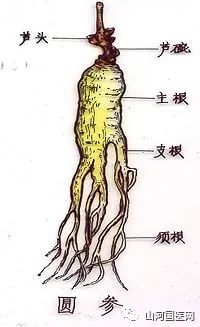
 Ginseng (Image 1)Chinese Name: GinsengPinyin Name: RenshenAlias: Bàng cuì, Shān shēn, Yuán shēn, Rén xián, Guǐ gài (Shén Nóng Běn Cǎo Jīng), Tǔ jīng, Shén cǎo, Huáng shēn, Xuè shēn (Wú Pǔ Běn Cǎo), Dì jīng (Guǎng Yǎ), Bǎi chǐ chǔ (Běn Cǎo Tú Jīng), Hǎi yú, Jīn jǐng yù lán, Hái ér shēn (Gāng Mù), Bàng cuì (Liáoníng Zhǔyào Yàocái).Botanical Family: AraliaceaeSource: The root of the Araliaceae plant Ginseng.
Ginseng (Image 1)Chinese Name: GinsengPinyin Name: RenshenAlias: Bàng cuì, Shān shēn, Yuán shēn, Rén xián, Guǐ gài (Shén Nóng Běn Cǎo Jīng), Tǔ jīng, Shén cǎo, Huáng shēn, Xuè shēn (Wú Pǔ Běn Cǎo), Dì jīng (Guǎng Yǎ), Bǎi chǐ chǔ (Běn Cǎo Tú Jīng), Hǎi yú, Jīn jǐng yù lán, Hái ér shēn (Gāng Mù), Bàng cuì (Liáoníng Zhǔyào Yàocái).Botanical Family: AraliaceaeSource: The root of the Araliaceae plant Ginseng.
Pharmacological Discussion
Nature and Taste: Neutral, Sweet, Slightly Bitter, Slightly Warm. Enters the Spleen and Lung Meridians.Effects: Greatly tonifies Yuan Qi, stabilizes collapse, tonifies the Spleen and benefits the Lung, generates fluids and quenches thirst, calms the spirit and benefits the mind.Indications: Deficiency due to overwork, poor appetite, fatigue, nausea and vomiting, diarrhea, weak cough and shortness of breath, spontaneous sweating, severe collapse, palpitations, forgetfulness, dizziness, headache, impotence, frequent urination, diabetes, uterine bleeding, pediatric convulsions, and all conditions of insufficient Qi, blood, and fluids.Dosage and Administration: Oral: Decoction, 3-10g, large doses 10-30g, preferably decocted separately; or powdered, 1-2g; or applied as a plaster; or soaked in wine; or made into pills or powders.Contraindications: Avoid in cases of excess conditions, heat syndromes, or when the righteous Qi is not deficient. Avoid using with Li Lu, Wu Ling Zhi, and Zao Jiao.Clinical Applications: 1. Yuan Qi Deficiency and Collapse. This herb can greatly tonify Yuan Qi and stabilize collapse, making it essential for rescuing from critical conditions. Suitable for extreme deficiency of Yuan Qi due to excessive sweating, diarrhea, blood loss, or prolonged illness, presenting with shortness of breath, fatigue, and weak pulse. Effective when used alone, as in Dú Rén Táng (独参汤) (Jǐng Yuè Quán Shū). If Qi deficiency with collapse is accompanied by sweating and cold extremities, it should be used with Fù Zǐ (附子) to tonify Qi and stabilize collapse, as in Shēn Fù Táng (参附汤) (Zhèng Tǐ Lèi Yào). If Qi deficiency with collapse is accompanied by sweating and warm body, thirst with a preference for cold drinks, and a red, dry tongue, this herb can also generate fluids and is often combined with Mài Dōng (麦冬) and Wǔ Wèi Zǐ (五味子) to tonify Qi and nourish Yin. 2. Lung, Spleen, Heart, and Kidney Qi Deficiency. This herb is a key remedy for tonifying the Lung and can improve symptoms of shortness of breath, weak voice, and other signs of Lung Qi deficiency. It treats cough and asthma with phlegm, often combined with Wǔ Wèi Zǐ, Sū Zǐ, and Xìng Rén (杏仁), as in Bǔ Lungs Táng (补肺汤) (Qiān Jīn Fāng). Ginseng is a perennial herb that prefers cool, moist climates, often growing in mixed coniferous and broadleaf forests at altitudes of 500-1100 meters with small temperature differences between day and night. Due to its large, spindle-shaped root, which often forks, it resembles a human head, hands, feet, and limbs, hence the name Ginseng. In ancient times, Ginseng was elegantly referred to as Huáng Jīng, Dì Jīng, and Shén Cǎo. Ginseng is known as the “King of Herbs” and is one of the famous “Three Treasures of Northeast China” (Ginseng, Sable Fur, Deer Antler), a precious medicinal material known both domestically and internationally.“Explanation of Names” also includes Huáng Shēn, Xuè Shēn, Rén xián, Guǐ gài, Shén cǎo, Tǔ jīng, Dì jīng, Hǎi yú, and Zhòu Miàn Huán Dān.“Taste and Properties” (Root): Sweet, Slightly Cold, Non-toxic.“Indications”1. Symptoms of Yin Deficiency and Yang Exhaustion (dizziness, spontaneous sweating, wheezing, weak pulse). Use 10 taels of finely chopped Ginseng, soak in 20 bowls of water, and simmer over a slow fire until it becomes a paste. Take 1-3 bowls each time until recovery. This formula is called “Ginseng Paste”.2. Chest fullness and rebellious Qi under the ribs. Use Ginseng, Bái Zhú (白术), Gān Jiāng (干姜), and Gān Cǎo (甘草) each 3 taels, add 8 sheng of water, and decoct until 3 sheng remain. Take 1 sheng, three times a day. This formula is called “Zhì Zhōng Táng” (治中汤) (Lǐ Zhōng Táng). 3. Spleen and Stomach Qi Deficiency, lack of appetite. Use 1 qian of Ginseng, 2 qian of Bái Zhú, 1 qian of Fú Lìng (茯苓), 5 fen of Gān Cǎo, 3 slices of Ginger, and 1 date, add 2 cups of water, decoct until 1 cup remains, and take warm before meals. This formula is called “Sì Jūn Zǐ Táng” (四君子汤) (Note: The quantities of each herb are not discounted in this formula).4. Opens the appetite and transforms phlegm. Use 2 taels of Ginseng (roasted), 5 qian of Bàn Xià (半夏) (roasted with ginger juice), grind into powder, and mix with flour to form balls the size of mung beans. Take 30-50 balls with ginger soup after meals, three times a day. Adding 5 qian of Chén Pí (陈皮) is also acceptable.5. Cold stomach fullness, inability to eat due to hunger. Use 2 qian of Ginseng, 0.5 qian of Shēng Fù Zǐ (生附子), 2 qian of Shēng Jiāng (生姜), add 7 he of water, decoct to 2 he, and mix with one egg white, take on an empty stomach.6. Stomach deficiency with bad habits or vomiting with phlegm. Use 1 tael of Ginseng, add 2 bowls of water, decoct to 1 bowl, then add 1 cup of bamboo juice and 3 spoons of ginger juice. Take warm. This formula is most suitable for the elderly.7. Rebellious Qi (vomiting immediately after eating, patient weak and powerless). Use 3 taels of Ginseng, sliced, add 1 sheng of water, boil to 4 he, take hot. At the same time, use Ginseng juice mixed with egg white and Xiāo Bái (即头) to eat with corn porridge.8. Abdominal pain and sour vomiting in pregnant women, inability to eat. Use equal parts of Ginseng and roasted ginger, make into balls the size of walnuts. Take 50 balls with rice soup.9. Yang deficiency with asthma, spontaneous sweating, night sweats, shortness of breath, and dizziness. Use 5 qian of Ginseng and 1 tael of cooked Fù Zǐ, divide into four doses. Each dose with 10 slices of ginger, add 2 bowls of water, decoct to 1 bowl, take warm.10. Severe asthma. Use powdered Ginseng decocted in soup, take 1 teaspoon, five to six times a day.11. Postpartum asthma. Use 1 tael of powdered Ginseng; also use 2 taels of Sū Mù (苏木), add 2 bowls of water, decoct to 1 bowl, then mix in Ginseng powder for internal use. It has special effects.12. Postpartum deficiency, fever, and spontaneous sweating. Use equal parts of Ginseng and Dāng Guī (当归) in powder; also use 3 sheng of water, add one pig’s kidney (sliced), half a cup of glutinous rice, and 2 green onions, cook the rice until done. Take 1 bowl of juice, mix in Ginseng and Dāng Guī powder, and take warm before meals.13. Postpartum constipation with excessive bleeding. Use Ginseng, Má Zǐ Rén (麻子仁), and Zhǐ Ké (枳壳) (stir-fried with wheat bran), grind finely, mix with honey to form balls the size of walnuts. Take 50 balls with rice soup.14. Transverse birth. Use powdered Ginseng and powdered Rǔ Xiāng (乳香) each 1 tael, and 5 fen of Dān Shā (丹砂), grind finely, mix with one egg white and 3 spoons of ginger juice, stir well and take cold. It has special effects.15. Palpitations and spontaneous sweating, insufficient heart Qi. Use equal parts of Ginseng and Dāng Guī, and one pair of pig kidneys (sliced), decoct together, take on an empty stomach. The dregs can be dried and ground into powder, mixed with yams to form balls the size of mung beans. Take 50 balls with jujube soup. You can also add 2 qian of Rǔ Xiāng.16. Chronic cough due to Lung deficiency. Use 2 taels of Ginseng and 1 tael of cooked deer antler glue, grind into powder, take 3 qian each time, with mint soup (like scallions) to wash down.17. Coughing with blood, weak pulse. Use 3 qian of powdered Ginseng, mix with egg white, take in the morning, and lie flat after taking. For those with short illnesses, one dose can cure. For chronic cases, two doses are effective. Using black chicken egg white for the medicine yields better results.18. Coughing up blood. Use equal parts of Ginseng, Huáng Qí (黄芪), and flour, and 5 qian of Bǎi Hé (百合), grind into powder, make into balls the size of walnuts. Take 50 balls before meals, with Màogēn soup. Another formula: Ginseng, Rǔ Xiāng, and Dān Shā, equal parts, add black plum meat to make balls the size of bullets, take one ball daily, with boiling water.19. Vomiting blood and blood in stools, blood gushing like a spring. Use 5 qian of Ginseng (roasted), 5 qian of Cè Bǎi Yè (侧柏叶) (steamed and roasted), and 5 qian of Jīng Jiè (荆芥穗) (burned to preserve), grind into powder. Each time take 2 qian, mix with 2 qian of flour, and eat with water.20. Nosebleeds that do not stop. Use equal parts of Ginseng and tender willow branches, grind into powder. Take 1 qian each time, three times a day. If no willow branches are available, lotus seed heart can be used instead.21. Yin deficiency with blood in urine. Use roasted Ginseng and Huáng Qí (黄芪) in equal parts; also use one red-skinned radish, cut into four slices and honey-roasted, roast until 2 taels of honey is used up. Each time take one slice of radish dipped in the medicine, with salt water.22. Thirst. Use powdered Ginseng mixed with egg white. Take 1 qian each time, three to four times a day. Another formula: Ginseng and Guā Lóu Gēn (栝楼根) in equal parts, grind into powder, mix with honey to form balls the size of walnuts. Take 100 balls before meals with Mài Dōng decoction. Take twice a day. This formula is called “Yù Hú Wán” (玉壶丸). Another formula: 1 tael of Ginseng, 2 taels of Gān Cǎo (甘草) (soaked in male pig bile and roasted), and 0.5 qian of brain powder, grind into powder, mix with honey to form balls the size of lotus seeds. Chew one ball each time, with cold water. Another formula: 1 tael of Ginseng, 2 taels of Gě Fěn (葛粉), grind into powder. At the same time, in 1 sheng of pig soup, add 3 qian of medicine and 2 taels of honey, simmer slowly to make a paste. Take one spoonful each night. Three doses yield results.23. Chronic dysentery with fainting, six pulses sinking and fragrant. Use 1.5 taels of Ginseng and Fù Zǐ, each half tael, take half tael each time, add 10 slices of ginger, 15 cloves, and a pinch of glutinous rice, decoct in 2 bowls of water until 1.5 bowls remain, take warm on an empty stomach.24. Dysentery with mouth restrictions. Use 3 qian of Ginseng and lotus meat, decoct into a thick soup, and swallow slowly. Alternatively, add ginger juice and stir-fried Huang Lián (黄连) 3 qian and decoct together.25. Elderly with chronic dysentery that does not stop, unable to eat. Use 1 tael of Ginseng, 1 tael of deer antler, and 5 qian of deer antler (peeled and roasted), grind into powder, take 1 teaspoon with rice soup. Take three times a day.26. Typhoid fever with severe symptoms (typhoid or other epidemics, prolonged illness, weak body, pulse sinking and hidden). Use 1 tael of Ginseng, add 2 cups of water, decoct to 1 cup, take after cooling with well water. Soon, the nose bridge will sweat, indicating the medicine is effective. This formula is called “Duó Mìng Sǎn” (夺命散) (also known as “Fù Mài Táng”).27. Typhoid with reversed Qi (slight fever, irritability, six pulses sinking and thin). Use half a tael of Ginseng, boil in water, mix with 2 qian of Nán Xīng (南星) bile, take warm.28. Wind pain in muscles and bones. Use 4 taels of Ginseng, soak in wine for three days, take out and dry, grind with 1 jin of Tǔ Fú Lìng (土茯苓) and 1 tael of Shān Cí Gū (山慈姑), mix with honey to form balls the size of walnuts. Take 100 balls before meals with rice soup.29. Pediatric convulsions due to wind. Use equal parts of Ginseng, Hā Fěn (蛤粉), and Dān Shā, mix with pig’s blood to form balls the size of mung beans. Take 50 balls with Jīn Yín soup. Take twice a day.30. Pediatric fright with squinting eyes. Use 1 qian each of Ginseng, Ā Jiāo (阿胶), and glutinous rice (stir-fried into pearls), add 1 bowl of water, decoct to 70%, take warm. Take twice a day.31. Stings from centipedes and wasps. Use powdered Ginseng for topical application.
Related Information
Ginseng Hair Roots: Mostly red ginseng roots, similar in properties to red ginseng but with milder effects.Raw Dried Ginseng: Has a more neutral nature, neither warming nor drying, can tonify Qi and generate fluids, suitable for strengthening the body and enhancing disease resistance.White Ginseng (Sugar Ginseng): Often made from shorter, lower-quality Korean ginseng, briefly boiled in hot water, soaked in sugar juice, and then dried.Effects of White Ginseng (Sugar Ginseng): Most neutral, relatively mild effects, suitable for tonifying the Spleen and benefiting the Lung.Wild Mountain Ginseng: Has no warming or drying properties, greatly tonifies Yuan Qi, considered the best among ginseng, but is rare and expensive, rarely used.Red Ginseng: Steamed for 2 hours until fully cooked, dried, and then pressed into irregular cylindrical shapes. Effects of Red Ginseng: Warming and tonifying. Tonifies Qi with a strong warming nature, suitable for emergency revival.
Selected Formulas
1. For Deficiency of Ying and Wei Qi: Weakness of the organs, fullness in the heart and abdomen, no appetite, intestinal sounds, diarrhea, and vomiting: Ginseng (remove the husk), Bái Zhú, Fú Lìng (remove skin), Gān Cǎo (roasted) in equal parts. Grind into fine powder, take 2 qian each time, with 1 cup of water, decoct to 7 parts, take orally at any time, add a little salt, white soup is also acceptable. Regular use warms the Spleen and Stomach, increases appetite, and dispels cold and dampness. (Jù Fāng Sì Jūn Zǐ Táng)2. For Cold Stomach Qi Deficiency, fullness in the middle, inability to digest, good appetite but unable to eat: Use 2 qian of Ginseng powder, 0.5 qian of Shēng Fù Zǐ powder, and 1 fen of Shēng Jiāng (chopped). Mix these three ingredients, use 7 he of water, decoct to 2 he, take one egg to clarify, stir, and take on an empty stomach. (Shèng Jì Zǒng Lù Wēn Wèi Zhǔ Sàn)3. For Lung Qi Deficiency with cough and phlegm, coughing up pus and blood, facial sores, and generalized swelling: Use one pair of Hā Jiè (蛤蚧) (whole, soaked in river water for five nights, changing water daily, wash off the fishy smell, and roast until yellow), 5 taels of Xìng Rén (remove skin and tip, roasted), and Gān Cǎo (roasted) each 5 taels, and 2 taels each of Zhī Mǔ (知母), Sāng Bái Pí (桑白皮), Ginseng, Fú Lìng (remove skin), and Bèi Mǔ (贝母). Grind these eight ingredients into powder, store in a clean container. Use daily as tea. (Wèi Shēng Bǎo Jiàn Rén Shēn Hā Jiè Sǎn)4. For Yang Deficiency with asthma, spontaneous sweating, night sweats, shortness of breath, and dizziness: Use 5 qian of Ginseng and 1 tael of cooked Fù Zǐ, divide into four doses, each dose with 10 slices of ginger, 2 bowls of water, decoct to 1 bowl, take warm after meals. (Jì Shēng Fāng)5. For Unstable Heart Qi, insufficient organs, confusion, palpitations, forgetfulness, nightmares, fear and restlessness, mood swings: Use Yuán Zhǐ (去苗及心) and Chāng Pú (菖蒲) each 2 taels, Ginseng and Bái Fú Lìng (去皮) each 3 taels. Grind into fine powder, make honey pills the size of wutong seeds, coat with red mercury. Take 7 pills, increasing to 20 pills, with warm rice drink after meals. (Jù Fāng Dìng Zhì Wán)6. For Diabetes with excessive drinking: Use equal parts of Ginseng and Guā Lóu Gēn, grind into powder, mix with honey to form balls the size of walnuts, take 30 balls with Mài Dōng soup. (Rén Zhāi Zhí Zhǐ Fāng Yù Hú Wán)7. For Diabetes with excessive drinking: Use powdered Ginseng, mix with egg white, take 1 qian, three to four times a day. (Gāng Mù)
Health Benefits
Beauty Value
Ginseng has been known as the “King of Herbs” since ancient times and is regarded as the finest for “nourishing Yin, replenishing life, and strengthening the foundation” in Eastern medicine. Ginseng contains various saponins and polysaccharides, and its extract can be slowly absorbed by the skin without any adverse effects, expanding skin capillaries, promoting blood circulation, increasing skin nutrition, regulating the water-oil balance of the skin, preventing dehydration, hardening, and wrinkling. Long-term use of products containing Ginseng can enhance skin elasticity and rejuvenate cells. Additionally, the active substances in Ginseng can inhibit the reduction of melanin, resulting in fair and smooth skin. Its beauty effects are numerous, making it a premium choice for skincare. Ginseng added to shampoos can expand the capillaries in the scalp, increasing hair nutrition, improving hair strength, and reducing hair loss and breakage, while also protecting damaged hair. Internally, Ginseng not only strengthens the body but also has anti-aging and skincare effects. Soaking Ginseng directly in 50% glycerin for 10 days can be used for facial massage, or making a strong Ginseng decoction to add to facial wash water can keep the skin well-moisturized.
Health Recipes
Ginseng Nutritional RiceIngredients: 3 cups of rice, 2 fresh Ginseng roots, 5 jujubes, 4 chestnuts, 5 tablespoons of red beans, 3 tablespoons of black beans, 3 cups of water.Cooking Method: Clean the fresh Ginseng and cut into appropriate pieces. Wash the rice and soak in water for 30 minutes, then drain. Remove the seeds from the jujubes and slice them, and cut the chestnuts into thick pieces. Soak the red and black beans until soft. After boiling the red beans, add them to the pot with the rice and prepared ingredients, then add water to cook. Once the rice soup boils, simmer on low heat until done.Ginseng Stir-Fried ShrimpIngredients: 2 fresh Ginseng roots, 4 large shrimp, 1/4 onion, 1/4 large chili, 1/3 yellow chili, 1 tablespoon of salad oil, 1.5 tablespoons of soy sauce, 1/2 tablespoon of sugar syrup, a pinch of salt.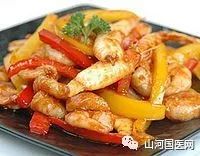
 Ginseng Stir-Fried ShrimpCooking Method: Clean the fresh Ginseng and slice it. Wash the large shrimp in salt water, peel and remove the head, then cut into cubes. Cut the onion and large chili into appropriate pieces. Heat the wok, add salad oil, and sauté the onion and large chili for a while, then add Ginseng and soy sauce, and sugar syrup to stir-fry until cooked. The shrimp and vegetables are nutritious, and Ginseng stir-fried shrimp is a nutritious meal for the whole family.
Ginseng Stir-Fried ShrimpCooking Method: Clean the fresh Ginseng and slice it. Wash the large shrimp in salt water, peel and remove the head, then cut into cubes. Cut the onion and large chili into appropriate pieces. Heat the wok, add salad oil, and sauté the onion and large chili for a while, then add Ginseng and soy sauce, and sugar syrup to stir-fry until cooked. The shrimp and vegetables are nutritious, and Ginseng stir-fried shrimp is a nutritious meal for the whole family.
Consumption Methods
China has a long history of consuming Ginseng, and its miraculous effects are highly praised. Historical records state that Ginseng has the effects of “nourishing the five organs, calming the spirit, stabilizing the soul, stopping palpitations, and enhancing vision and intelligence.” Its consumption methods are quite particular:(1) Stewing. Cut Ginseng into 2cm thick slices, place in a porcelain bowl, fill with water, seal the bowl, and steam for 4-5 hours before consuming.(2) Chewing. Place 2-3 slices of Ginseng in the mouth and chew slowly, generating saliva and refreshing the mind, which is the simplest method of consumption.(3) Grinding into powder. Grind Ginseng into fine powder, swallow daily, with the amount depending on individual constitution, generally 1-1.5 grams each time.(4) Brewing tea. Cut Ginseng into thin slices, place in a bowl or cup, pour boiling water over it, cover for 5 minutes before consuming.(5) Soaking in alcohol. Cut the whole Ginseng into thin slices and soak in 50-60 degree white liquor, consume as desired.(6) Cooking with food. Ginseng often has a certain bitterness when consumed; if cooked with lean meat, chicken, or fish, the bitterness can be eliminated, providing nourishment and strength.
Precautions for Consumption
1. Ginseng should not be used indiscriminately. Ginseng is a Qi-tonifying herb; if there are no symptoms of Qi deficiency, it is not suitable for casual consumption. Strong individuals without weakness do not need to take tonics. Misuse or excessive use can lead to Qi stagnation, resulting in chest tightness and abdominal distension. Some people mistakenly believe that Ginseng is a supplement that is always beneficial, which is incorrect. Whether red ginseng or raw dried ginseng, it should be taken gradually and not rushed, and excessive consumption should be avoided. Additionally, seasonal changes should be noted; generally, it is better to consume in autumn and winter when the weather is cool, while summer heat makes it unsuitable for consumption.2. After taking Ginseng, avoid eating radishes (including red, white, and green radishes) and various seafood. Ancient medical texts state that radishes “descend Qi and digest food…” Modern research shows that radishes aid digestion and diuresis, which aligns with ancient views. Ginseng’s primary function is to tonify Yuan Qi. These two functions counteract each other, hence the prohibition.3. Avoid drinking tea. After taking Ginseng, do not drink tea to prevent diminishing its effects.4. Whether decocting or stewing, avoid using metal cookware.
Storage Methods
Ginseng contains a lot of sugars, mucilage, and volatile oils, making it prone to moisture, oiliness, mold, discoloration, and insect infestation. There are several methods for storing Ginseng:1. Conventional storage method: For thoroughly dried Ginseng, seal in a plastic bag to isolate from air and store in a cool place.2. Desiccant drying method: Place an appropriate amount of desiccant, such as quicklime or charcoal, at the bottom of a sealed jar, tube, or box, then wrap the Ginseng in paper and place it inside, sealing it tightly.3. Low-temperature storage method: This is the ideal method. Ginseng should be dried before storage, with the best exposure time from 9 AM to 4 PM, but it should not be exposed for too long. Generally, it only needs to be turned over for 1-2 hours in the afternoon. After cooling, wrap the Ginseng in a plastic bag, seal tightly, and store in the freezer for long-term preservation.
Ginseng Culture
The King of Herbs
Ginseng is a specialty of Northeast China, and its use in Chinese medicine has a long history. As early as the Warring States period, the great physician Bian Que had an understanding of the properties and effects of Ginseng; the “Shén Nóng Běn Cǎo Jīng” from the Qin and Han dynasties listed it as a top-grade herb. The famous Chinese medicine scholar Gong Juzhong in the Ming Dynasty listed it first in the “Four Hundred Flavors Song”: “Ginseng is sweet, greatly tonifies Yuan Qi, quenches thirst, and regulates nutrition and defense,” becoming the first line of many TCM practitioners’ memorization songs.

